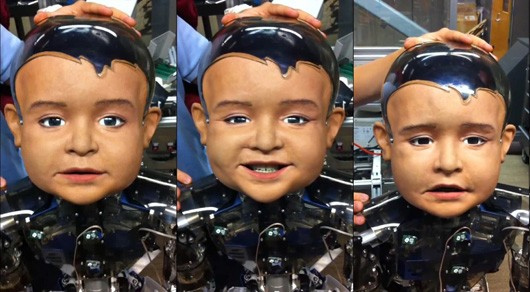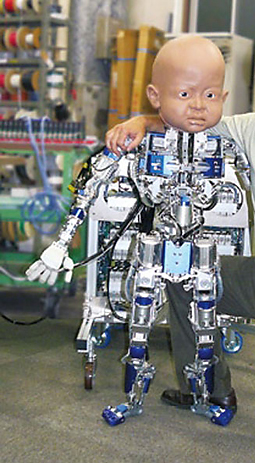UCSD introduces Diego-san, a baby robot with ‘tude
January 10, 2013

“I’m what? A robot? … Cool! … Uh, maybe not.” Diego-san demonstrating different facial expressions, using 27 moving parts in the head alone (credit: UCSD)
UCSD has introduced Diego-san, a new humanoid robot who mimicks the expressions of a one-year-old child
Demonstrated at CES and in a video, the robot will be used in studies on sensory-motor and social development — how babies “learn” to control their bodies and to interact with other people.
Diego-san’s hardware was developed by two leading robot manufacturers: the head by Hanson Robotics and the body by Japan’s Kokoro Co. The project is led by University of California, San Diego full research scientist Javier Movellan.
Movellan directs the Institute for Neural Computation’s Machine Perception Laboratory, based in the UCSD division of the California Institute for Telecommunications and Information Technology (Calit2). The Diego-san project is also a joint collaboration with the Early Play and Development Laboratory of professor Dan Messinger at the University of Miami, and with professor Emo Todorov’s Movement Control Laboratory at the University of Washington.
Movellan and his colleagues are developing the software that allows Diego-san to learn to control his body and to learn to interact with people.

An earlier (apparently bummed-0ut) version of the Diego-san robot (credit: UCSD)
“We developed machine-learning methods to analyze face-to-face interaction between mothers and infants, to extract the underlying social controller used by infants, and to port it to Diego-san,” said Movellan. “We then analyzed the resulting interaction between Diego-san and adults.”
“This robotic baby boy was built with funding from the National Science Foundation and serves cognitive A.I. and human-robot interaction research,” wrote Hanson.
“With high definition cameras in the eyes, Diego San sees people, gestures, expressions, and uses A.I. modeled on human babies, to learn from people, the way that a baby hypothetically would. The facial expressions are important to establish a relationship, and communicate intuitively to people.”
Social robots
Diego-san is the next step in the development of “emotionally relevant” robotics, building on Hanson’s previous work with the Machine Perception Lab, such as the emotionally responsive Albert Einstein head.
The robot is a product of the “Developing Social Robots” project launched in 2008. The goal of the project was “to make progress on computational problems that elude the most sophisticated computers and Artificial Intelligence approaches, but that infants solve seamlessly during their first year of life.”
For that reason, the robot’s sensors and actuators were built to approximate the levels of complexity of human infants, including actuators to replicate dynamics similar to those of human muscles. The technology should allow Diego-san to learn and autonomously develop sensory-motor and communicative skills typical of one-year-old infants.
“Its main goal is to try and understand the development of sensory motor intelligence from a computational point of view,” explained principal investigator Movellan. “It brings together researchers in developmental psychology, machine learning, neuroscience, computer vision and robotics. Basically we are trying to understand the computational problems that a baby’s brain faces when learning to move its own body and use it to interact with the physical and social worlds.”
The researchers are interested in studying Diego-san’s interaction with the physical world via reaching, grasping, etc., and with the social world through pointing, smiling and other gestures or facial expressions.
As outlined in the original proposal to the NSF, the project is “grounded in developmental research with human infants, using motion capture and computer vision technology to characterize the statistics of early physical and social interaction. An important goal is to foster the conceptual shifts needed to rigorously think, explore, and formalize intelligent architectures that learn and develop autonomously by interaction with the physical and social worlds.”
According to UCSD’s Movellan, the expression recognition technology his team developed for Diego-san has spawned a startup called Machine Perception Technologies (MPT). The company is currently looking for undergraduate interns and postgraduate programmers.
The project may also open new avenues to the computational study of infant development and potentially offer new clues for the understanding of developmental disorders such as autism and Williams syndrome.
This spring, Swiss researchers will demonstrate their nearly 4-foot-tall Roboy robot toddler (with a face selected via a Facebook contest).